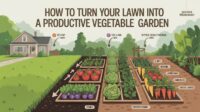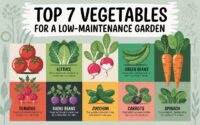The Best Vegetables for Kids to Grow and Eat
Published: 2025-10-19
Introduction: Why Gardening Is Great for Kids
Gardening with kids is more than a fun weekend activity. It teaches responsibility, patience and healthy eating habits. Because children are naturally curious, planting seeds and watching them grow sparks excitement. Moreover, when kids grow their own vegetables, they are more likely to eat them.
This hands-on experience connects children to nature. It reduces screen time and encourages outdoor play. Whether you have a backyard or a few containers, gardening can be adapted to any space. With the right vegetables, kids can enjoy quick results and tasty rewards.
What Makes a Vegetable Kid-Friendly?
Not all vegetables are created equal when it comes to kids. Some are easier to grow, more colorful or sweeter in taste. Kid-friendly vegetables should be:
- Fast-growing to maintain interest
- Easy to plant and harvest
- Visually appealing and fun to touch
- Mild in flavor and enjoyable to eat
Because children respond well to sensory experiences, vegetables with bright colors and interesting shapes are ideal. Crunchy textures and sweet flavors also help build enthusiasm.
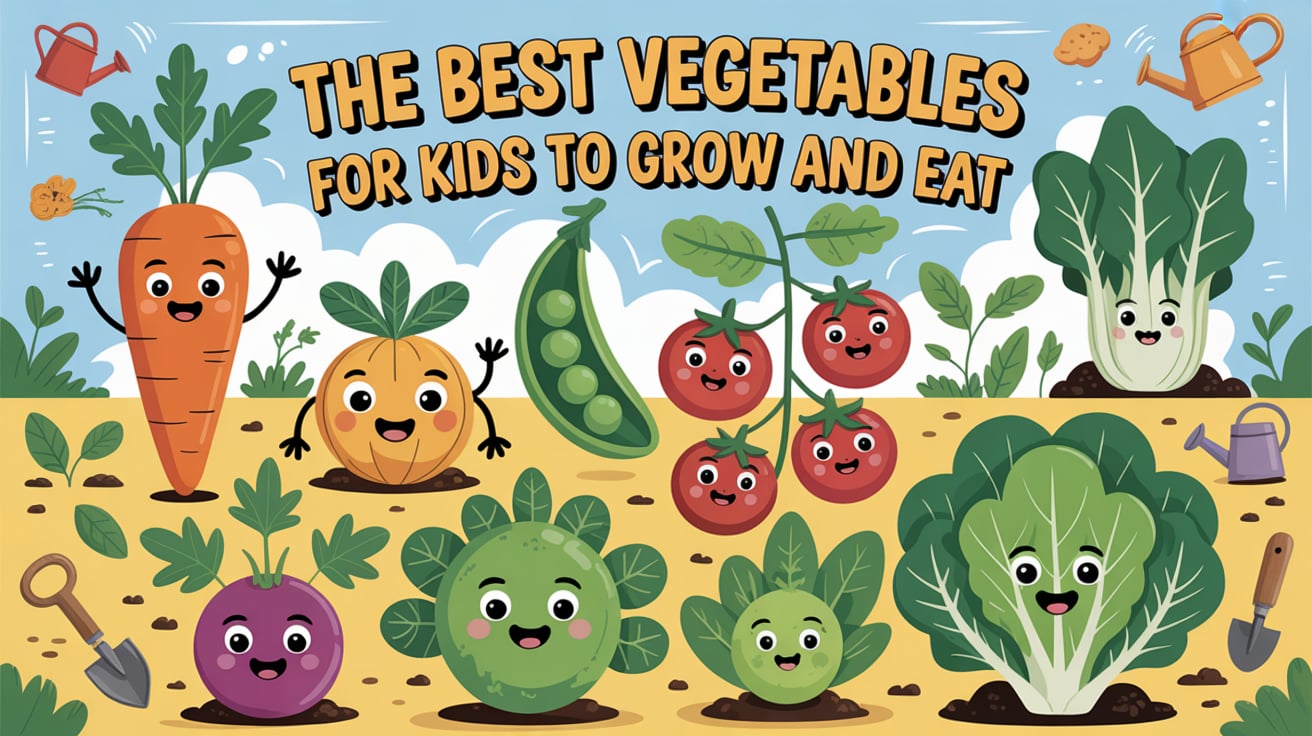
1. Lettuce: Quick and Colorful
Lettuce is one of the easiest vegetables for kids to grow. It germinates quickly and can be harvested within weeks. Loose-leaf varieties like Buttercrunch and Red Salad Bowl offer vibrant colors and soft textures.
Moreover, lettuce grows well in containers and raised beds. It requires minimal care and tolerates partial shade. Kids can snip leaves as needed and watch them regrow.
Because lettuce is used in sandwiches and salads, children see the connection between garden and plate. This encourages healthy eating and reduces food waste.
2. Carrots: Sweet and Crunchy
Carrots are a favorite among children. Their sweet flavor and crunchy texture make them fun to eat. Growing carrots teaches patience, as they develop underground.
Short varieties like Thumbelina and Little Finger are perfect for small hands. These carrots grow well in loose soil and containers. Kids enjoy pulling them out and discovering their shape.
Moreover, carrots come in colors like orange, purple and yellow. This adds excitement and variety. Because they store well, carrots can be enjoyed long after harvest.
3. Bush Beans: Fast and Fun
Bush beans are ideal for kids. They grow quickly and produce pods within 50 days. Unlike pole beans, they do not require trellises. This makes them easy to manage.
Children enjoy picking beans and snapping them open. The process is interactive and rewarding. Beans are also rich in protein and fiber, supporting healthy growth.
Moreover, bush beans improve soil health by fixing nitrogen. This teaches kids about plant relationships and sustainability. With minimal care, beans provide a generous harvest.
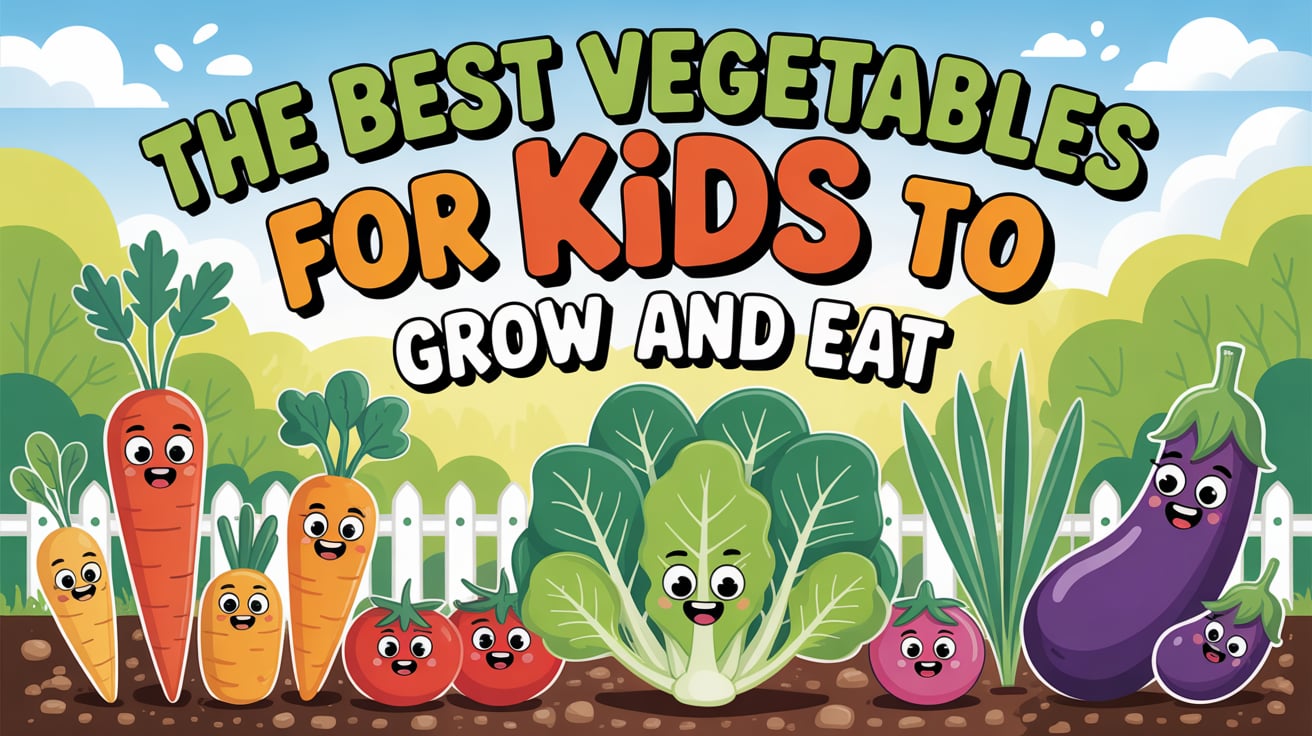
4. Cucumbers: Cool and Crisp
Cucumbers are refreshing and easy to grow. They thrive in warm weather and produce fruit rapidly. Kids love their crunchy texture and mild taste.
Bush varieties like Spacemaster are compact and suitable for containers. Vining types can be trained on trellises for vertical gardening. This saves space and adds visual interest.
Moreover, cucumbers can be sliced, pickled or eaten whole. Their versatility makes them popular among children. Because they grow abundantly, kids feel successful and motivated.
Cherry tomatoes are perfect for kids. They are small, sweet and easy to harvest. Varieties like Sweet 100 and Sungold produce clusters of fruit throughout the season.
Tomatoes require full sun and regular watering. However, they are forgiving and resilient. Kids enjoy watching the green fruit turn red or yellow.
Moreover, cherry tomatoes can be eaten straight from the vine. This builds a direct connection between gardening and snacking. Because they are colorful and juicy, kids rarely resist them.
6. Corn: Tall and Impressive
Corn adds drama to the garden. Its tall stalks and golden ears capture attention. Kids enjoy planting kernels and watching them grow into towering plants.
Sweet corn varieties like Golden Bantam are popular. They require space and sunlight but offer a rewarding harvest. Pollination occurs naturally through wind, adding a science lesson.
Moreover, corn can be grilled, boiled or popped. This versatility makes it exciting for children. Because it grows in stages, corn teaches patience and observation.

7. Radishes: Fast and Colorful
Radishes are among the fastest vegetables to grow. They mature in just 25 days and come in vibrant colors. Varieties like Cherry Belle and Easter Egg are ideal for kids.
Radishes grow well in containers and small plots. They require minimal care and tolerate cool weather. Kids enjoy pulling them out and tasting their peppery flavor.
Moreover, radishes can be sliced or roasted. Their unique taste introduces children to new flavors. Because they grow quickly, they maintain interest and excitement.
| Peas: Sweet and Interactive |
|---|
ike Sugar Snap and Little Marvel are perfect for small gardens. Peas grow best in cool weather and require support. Trellises or cages help them climb and stay healthy. Children can help train the vines and monitor growth. Moreover, peas are rich in vitamins and fiber. They support digestion and energy. Because they are easy to prepare, peas become a favorite snack. |
9. Bell Peppers: Colorful and Mild
Bell peppers are colorful and mild in flavor. They come in red, yellow, orange and green. Kids enjoy their crunchy texture and sweet taste.
Peppers require warm weather and full sun. They grow well in containers and raised beds. Varieties like Mini Bell and Sweet Banana are ideal for children.
Moreover, peppers can be sliced, stuffed or grilled. Their versatility makes them appealing. Because they are rich in vitamin C, they support immunity and skin health.
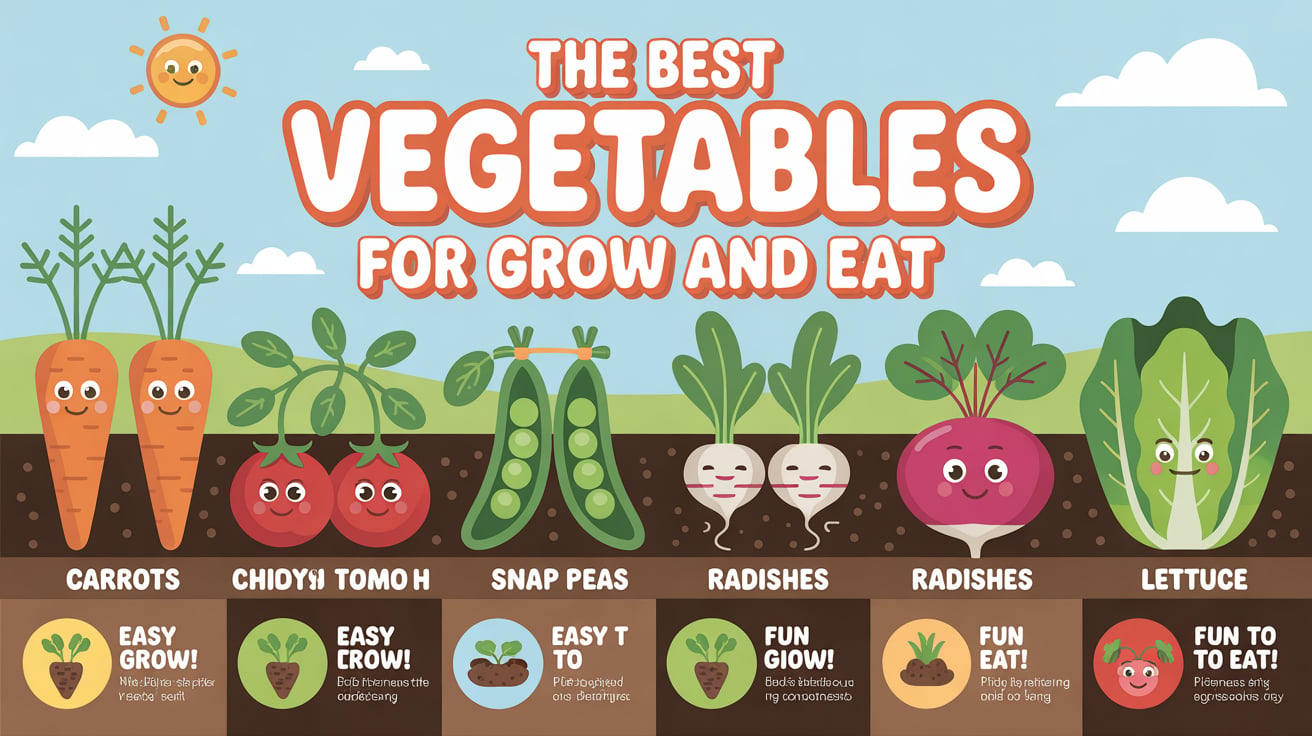
10. Zucchini: Abundant and Versatile
Zucchini is known for its prolific yield. Once established, it produces fruit continuously. Kids enjoy watching the large leaves and fast-growing squash.
Bush varieties like Black Beauty are compact and manageable. Zucchini grows well in warm weather and requires regular watering. Mulching helps retain moisture and suppress weeds.
Moreover, zucchini can be grilled, baked or spiralized. Its mild flavor suits many dishes. Because it grows abundantly, kids feel accomplished and proud.
| Benefits of Gardening for Children |
|---|
Gardening offers more than just fresh vegetables. It builds life skills and emotional resilience. Because kids are involved in planting and nurturing, they learn responsibility and patience. Watching a seed grow into a plant teaches them about effort and reward. Moreover, gardening improves focus and reduces stress. Time spent outdoors boosts mood and supports mental health. Children who garden are more likely to develop a love for nature and sustainability. Physical activity is also increased. Digging, watering and harvesting promote movement. This supports motor skills and overall fitness. Gardening becomes a full-body experience that engages mind and muscles. |
Educational Value of Vegetable Gardening
Gardening is a living classroom. It teaches science, math and environmental awareness. Kids learn about plant life cycles, photosynthesis and soil composition. Measuring growth and spacing plants introduces basic math skills.
Additionally, gardening encourages observation and critical thinking. Children ask questions and make predictions. They learn to solve problems and adapt to changes.
Because gardening is hands-on, lessons are retained longer. It supports experiential learning and curiosity. Schools and homeschoolers often use gardening to enrich education.
To keep kids interested, gardening must be fun and interactive. Start with easy vegetables and quick results. Use colorful tools and child-sized gloves. Let them choose seeds and decorate plant markers.
Create themed gardens like pizza gardens with tomatoes, basil and peppers. Build fairy gardens with edible flowers and herbs. These ideas spark imagination and ownership.
Moreover, involve kids in every step. Let them dig holes, water plants and harvest produce. Celebrate milestones like first sprouts and first harvests. This builds confidence and joy.
Container Gardening for Small Spaces
Not every family has a backyard. Container gardening makes vegetable growing accessible. Use pots, buckets or raised beds on balconies and patios. Choose compact vegetables like lettuce, radishes and cherry tomatoes.
Containers should have drainage holes and be placed in sunny spots. Soil should be rich and well-draining. Watering must be consistent but not excessive.
Moreover, vertical gardening saves space. Use trellises, hanging baskets and wall planters. This adds beauty and functionality. Kids enjoy arranging and decorating containers.
Seasonal Planting Guide for Kids
Understanding seasons helps kids plan and succeed. Cool-season vegetables like peas, lettuce and radishes grow in spring and fall. Warm-season crops like tomatoes, cucumbers and peppers thrive in summer.
Create a planting calendar with your child. Mark dates for sowing, transplanting and harvesting. This builds anticipation and structure.
Moreover, use indoor seed starting in winter. Grow microgreens and herbs on windowsills. This keeps gardening alive year-round and teaches indoor plant care.
Pests can frustrate young gardeners. Use safe and natural methods to protect plants. Companion planting with marigolds and basil repels insects. Neem oil and soap sprays are gentle and effective.
Handpicking pests teaches observation and courage. Encourage kids to look under leaves and spot damage. Use row covers and mulch to prevent infestations.
Moreover, attract beneficial insects like ladybugs and lacewings. Plant flowers that provide nectar and shelter. This creates a balanced ecosystem and reduces chemical use.
Cooking with Homegrown Vegetables
Cooking connects gardening to nutrition. Let kids wash, chop and prepare their harvest. Simple recipes like salads, stir-fries and veggie wraps are ideal.
Use child-safe tools and involve them in meal planning. Ask what they want to cook and how they want to serve it. This builds independence and creativity.
Moreover, discuss flavors and textures. Encourage tasting and experimenting. Cooking becomes a celebration of effort and learning.
| Safety and Hygiene in Kids’ Gardens |
|---|
Safety is essential. Use non-toxic tools and avoid sharp edges. Teach proper handwashing before and after gardening. Store tools safely and supervise watering. Avoid chemical fertilizers and pesticides. Use compost and organic amendments. Label plants clearly and keep pathways clear. Moreover, teach respect for nature. Explain how to handle insects and plants gently. Gardening becomes a lesson in care and responsibility. |
Building a Family Gardening Routine
Consistency helps kids stay engaged. Set a weekly gardening day or time. Make it part of your family rhythm. Use charts and journals to track progress.
Celebrate successes with garden parties or photo albums. Share harvests with neighbors and friends. This builds pride and community.
Moreover, rotate tasks to keep things fresh. One week may focus on planting, another on harvesting. This variety maintains interest and teaches flexibility.
FAQs
Lettuce radishes carrots and cherry tomatoes are beginner-friendly and fast-growing.
Even a few containers on a balcony can support vegetables.
Yes kids are more likely to eat vegetables they grow themselves.
Use plastic or rounded tools designed for small hands.
Choose fun vegetables celebrate milestones and involve them in cooking.
Absolutely it teaches science math and environmental awareness.
Use natural methods like neem spray and companion planting to manage them safely.
Conclusion: Growing More Than Vegetables
Gardening with kids grows more than food. It nurtures curiosity, confidence and connection. From planting seeds to sharing meals, every step builds life skills and joy.
By choosing the best vegetables for kids to grow and eat, families create lasting memories. Whether in a backyard or on a windowsill, gardening becomes a source of learning and love.

- Be Respectful
- Stay Relevant
- Stay Positive
- True Feedback
- Encourage Discussion
- Avoid Spamming
- No Fake News
- Don't Copy-Paste
- No Personal Attacks



- Be Respectful
- Stay Relevant
- Stay Positive
- True Feedback
- Encourage Discussion
- Avoid Spamming
- No Fake News
- Don't Copy-Paste
- No Personal Attacks

